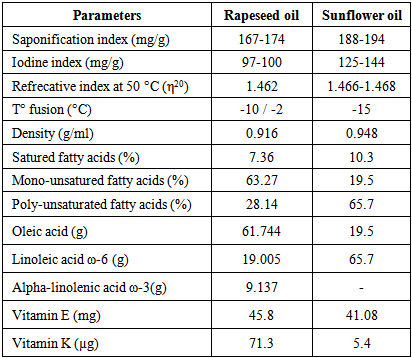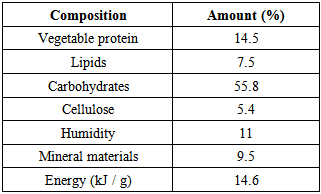-
Paper Information
- Next Paper
- Paper Submission
-
Journal Information
- About This Journal
- Editorial Board
- Current Issue
- Archive
- Author Guidelines
- Contact Us
American Journal of Biochemistry
p-ISSN: 2163-3010 e-ISSN: 2163-3029
2015; 5(5): 85-91
doi:10.5923/j.ajb.20150505.01

Study of Nutritional Effects of Rapeseed and Sunflower Oils on Ponderal and Biochemical Parameters in Wistar Rats
Abdelkrim Berroukche1, Kadda Hachem1, Yasmina Benabdesslem1, Wafa Siouda2, Samia Rekia Aoued1
1Laboratory of Biotoxicologie, Pharmacognosy and Biological Recycling Plant, Biology Department, Faculty of Sciences, Moulay Tahar University, Saida, Algeria
2Biology Department, Faculty of Sciences, Baji Mokhtar University, Annaba, Algeria
Correspondence to: Abdelkrim Berroukche, Laboratory of Biotoxicologie, Pharmacognosy and Biological Recycling Plant, Biology Department, Faculty of Sciences, Moulay Tahar University, Saida, Algeria.
| Email: |  |
Copyright © 2015 Scientific & Academic Publishing. All Rights Reserved.
This work is licensed under the Creative Commons Attribution International License (CC BY).
http://creativecommons.org/licenses/by/4.0/

Oilseeds are rich in mono-unsaturated (MUFAs) and poly-unsaturated fatty acids (PUFAs) as omega-3 and omega-6. These nutrients showed preventive and protective properties against obesity and cardiovascular diseases. This study aimed to assess the nutritional effects of rapeseed oil and sunflower oil on ponderal and biochemical parameters in rats. The experiments were carried out on 15 two months old rats, with a mean body weight of 55 g. The experiment lasted 4 weeks. Animals were assigned into 3 groups: group 1 (control), group 2 (fed with rapeseed oil) and group 3 (fed with sunflower oil). Weight gain was daily measured and biochemical parameters were weekly determined. The results showed a insignificant decrease in weight gain in animals of group 2 fed with rapeseed oil (32.12 ± 12.77 g), a significant reduction of serum HDL-cholesterol in group 3 fed with sunflower oil (0.83 ± 0.26 mMol / L), although serum total-triglycerides in groups 2 and 3 were not significantly lower than controls (2.63 ± 0.15 and 3.19 ± 0.61 vs 3.1 ± 0.58 mMol / L respectively). However rapeseed oil had showed lowering effects on the higher blood cholesterol and triglyceride levels.
Keywords: Poly-Unsaturated fatty acids, Cardiovascular diseases, Rapeseed oil, Sunflower Oil, Cholesterol, Triglyceride
Cite this paper: Abdelkrim Berroukche, Kadda Hachem, Yasmina Benabdesslem, Wafa Siouda, Samia Rekia Aoued, Study of Nutritional Effects of Rapeseed and Sunflower Oils on Ponderal and Biochemical Parameters in Wistar Rats, American Journal of Biochemistry, Vol. 5 No. 5, 2015, pp. 85-91. doi: 10.5923/j.ajb.20150505.01.
Article Outline
1. Introduction
- Further genetic and environnemental factors, nutrition substantially contributes to the occurrence and prevention of various diseases. Nutritional approaches could serve as a natural protective factor in case of dietary deficiencies and metabolic disorders such as diabetes, cardiovascular disease, osteoporosis and cancer [1]. According to the epidemiological studies, it is recommended to eat less fat in order to maintain an improved health status. It is obvious that the fats increase the risk of cardiovascular diseases, although they play an important role in human nutrition as a part of a balanced diet [2]. Lipids are contained in different foods and they contribute in flavor and taste, as well as in the transport of fat-soluble vitamins and energy [3]. The last decades, qualitative analysis of vegetable oils provides new insights. Oilseeds, such as rapeseed, sunflower, nuts and flax, are rich in essential fatty acids (EFAs), like ω-3 and ω-6 that human or animal body is unable to produce and are received by the diet or through supplements [4]. The hypercholesterolemic effects of the long chain saturated fatty acids (SFAs) on LDL-cholesterol but also HDL-cholesterol blood-levels are well established. Polyunsaturated fatty acids (PUFAs) of ω-3 and ω-6 series are involved in physiological processes such as the constitution and integrity of cell membranes, cardiovascular, brain, hormonal and inflammatory functions. These micronutrients cover the daily nutrient requirements and maintain balance between ω-3 and ω-6 [4]. The present experiment aims to assess the effect of supplementation either with rapeseed oil or sunflower oil on the body weight and lipid parameters in rats.
2. Material and Methods
2.1. Rapeseed Oil and Sunflower Oil
- Rapeseed oil (Brassica napus) and sunflower oil (Helianthus annuus), used in the present study, were purchased from shops in France, after the implementation of physicochemical and compositional analysis, which revealed their high content in MUFAs and PUFAs (Table 1).
|
2.2. Animals and Treatments
- Fifteen male Wistar rats (Rattus norvegicus var. albinus), aged 2 months old with an average body weight of 55 ± 10 g, were obtained from the Department of Biology at the University of Saida, Algeria. The animals were kept under standard environmental conditions (22±2°C; 12:12 h dark/light cycle). Water and commercial feed, obtained from the National Office of Feed for Cattle (NOFC, Algeria), were available ad libitum. The composition of control diet rat is showed in table 2. The experimental protocol was approved by the Animal Experimentation Ethics Committee of the UFPE (Process no. 012974) in accordance with the National Institute of Health Guidelines for the Care and Use of Laboratory Animals.
|
2.3. Distribution of Animals in Groups
- The fifteen rats were randomly allocated into three groups (n = 5 /group):Group 1 (Normal control rats): each rat received daily 100 g diet and water is supplied ad- libitum.Group 2 (experimental animals): each rat received daily 100 g diet and orally 1.5 ml rapeseed oil.Group 3 (experimental animals): each rat received daily 100 g diet and orally 1.5 ml sunflower oil.Body weight gain was daily evaluated during the whole experimental period (4 weeks). After 28 days of treatment, animals were anesthetized (sodium pentobarbital 40 mg/kg b.w.), blood samples were collected , remained for 20 min in laboratory temperature and then centrifuged for 10 min at 1500 g for serum separation [5].
2.4. Serum Assay of Lipids
- Determination of serum lipid levels (total-cholesterol, triglyceride, HDL-cholesterol and LDL-cholesterol) has been performed by an enzymatic colorimetric method as described by Kamelska et al. (2015) using SPINREACT commercial kits [6].
2.5. Statistical Analysis
- Data are expressed as means ± SD (standard deviation). The values were analyzed by one way analysis of variance (ANOVA) test on SigmaPlot software version 11.0. Differences at p < 0.05 were considered statistically significant.
3. Results and Discussion
- Weight gain values were not significantly different among the experimental groups; 31 ± 19.93; 32.12 ± 12.77 and 34.75 ± 20.64 g for group 1, 2 and 3, respectively (Table 3; p = 0.95). In Figure 1, values for during the whole experimental period are presented. Rats of group 2 (Rapeseed oil) showed a decrease in body weight between the 3rd and 4th week of experimentation but during the 4th week, an increase in weight was observed. These results are closely related to the amount of feed ingested. On the other hand, rats of group 1 and 3 showed a continuous increase of their body weight.
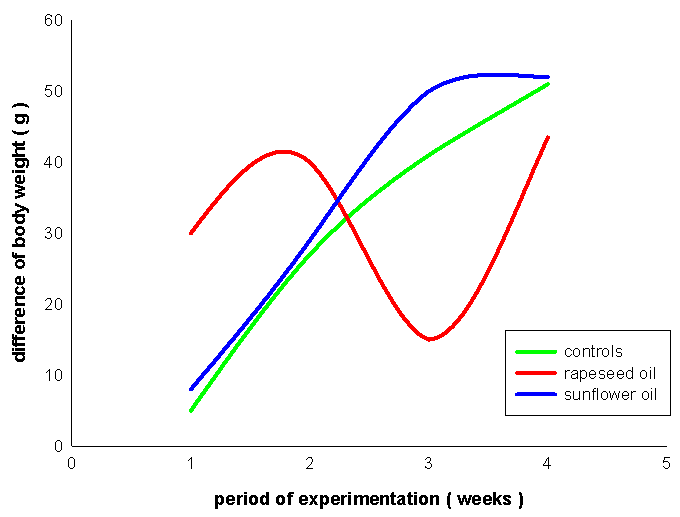 | Figure 1. Weight gain per week (g) in groups of rats during the whole experimental period |
 | Table 3. Ponderal and biochemical parameters in rats |
 | Figure 2. Serum total cholesterol in groups of rats during the whole experimental period |
 | Figure 3. Serum HDL-Cholesterol in groups of rats during the whole experimental period |
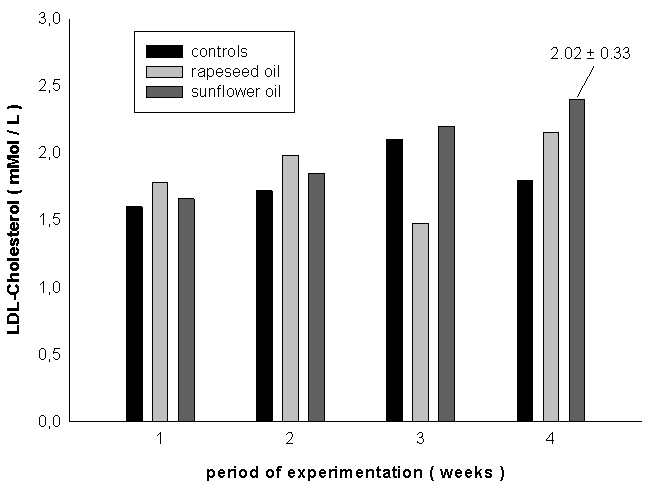 | Figure 4. Serum LDL-Cholesterol in groups of rats during the whole experimental period |
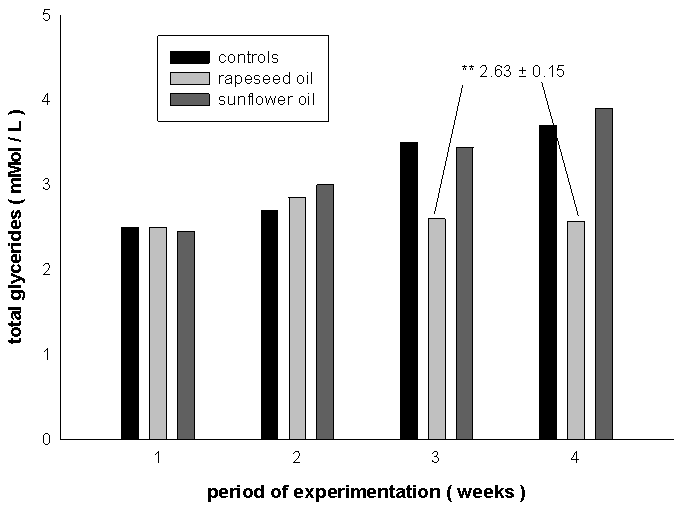 | Figure 5. Serum total triglycerides in groups of rats during the whole experimental period |
4. Conclusions
- As it is shown in the present study, supplementation with rapeseed oil and sunflower oil did not significantly affect growth performance and lipid parameters. Biochemical analysis showed that sunflower oil contributes to the reduction of HDL-cholesterol, while rapeseed oil did not have an effect on serum HDL-cholesterol levels.
ACKNOWLEDGEMENTS
- We thank the medical team of biology analysis laboratory, which under the leadership of Dr. Z. HADDI had enabled us to establish all the serum assay tests for biochemical parameters. Our thanks also go to members of the administration of our biology department (faculty of sciences, university of Saida, Algeria) for their help which materialized by putting at our disposal animals and their breeding.
 Abstract
Abstract Reference
Reference Full-Text PDF
Full-Text PDF Full-text HTML
Full-text HTML